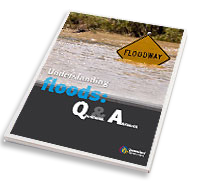Understanding floods
From December 2010 to January 2011, Queensland experienced widespread flooding, with three quarters of the state declared a disaster zone.
Understanding Floods: Questions and Answers was prepared by the Queensland Floods Science, Engineering and Technology (SET) Panel, convened by the Queensland Chief Scientist, Dr Geoff Garrett AO, to explain in clear and simple language the fundamental concepts of floods, including flood causes, impacts, forecasting, and flood risk management now and in the future.
Read the Queensland Government's information on flood awareness, preparation advice, assistance and recovery.
Queensland Chief Scientist, Dr Geoff Garrett, AO, and leading experts from the recent report Understanding floods: questions and answers, climatologist Professor Roger Stone, civil engineer Tony McAlister and water resources engineer Toby McGrath as they…
Queensland Chief Scientist, Dr Geoff Garrett, AO, and leading experts from the recent report Understanding floods: questions and answers, climatologist Professor Roger Stone, civil engineer Tony McAlister and water resources engineer Toby McGrath as they discuss what causes floods, how we can better manage and plan for floods and what we can expect in the future.

